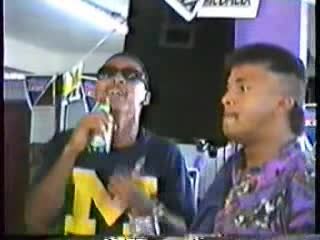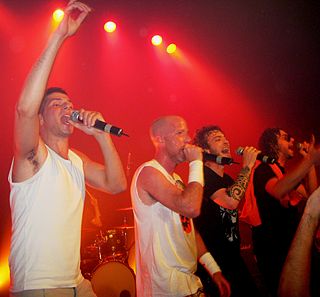Hip hop music has been popular in Africa since the early 1980s due to widespread African American influence. In 1985, hip hop reached Senegal, a French-speaking country in West Africa. Some of the first Senegalese rappers were Munyaradzi Nhidza Lida, M.C. Solaar, and Positive Black Soul.

Reggaeton is a modern style of popular and electronic music that originated in Panama during the late 1980s, and which rose to prominence in the late 1990s and early 2000s through a plethora of Puerto Rican musicians. It has evolved from dancehall, with elements of hip hop, Latin American, and Caribbean music. Vocals include toasting/rapping and singing, typically in Spanish.

The traditional music of Jordan has a long history. Rural zajal songs, with improvised poetry played with a mijwiz, tablah, arghul, oud, rabab, and reed pipe ensemble accompanying is popular. The transition of old cultural music into hit pop songs known worldwide. Recently, Jordan has seen the rise of prominent DJs and pop stars.
Korean hip-hop, also known as K-hip-hop or K-rap, is a subgenre of the South Korean popular music.

Israeli hip hop refers to hip hop and rap music in Israel. Israeli hip hop artists have mainly emerged from the populations of Mizrahi Jews, Ethiopian Jews, and Israeli-Arabs, though there have also been numerous artists from Israeli Ashkenazi Jews especially Hasidim. Israeli hip hop artists enjoy wide popularity in Israel and have succeeded in appealing to international markets particularly the United States.
Zimbabwean hip hop is a variety of hip hop music that is popular in Zimbabwe. It emerged in the early 1990s. Prominent artists include Young Gemini,Noluntu J, Voltz JT ,Br3eze, Ti Gonzi, Junior Brown, Calvin, Saintfloew, Holy Ten, Trey Heart, Asaph, Kriss Newtone, Suhn, Denim Woods, Hanna, Tanto Wavie, Tehn Diamond, Synik, Maskiri, T3rry Tempo, TreyXL, Munetsi, Bling4, Tha Bees, Bagga We Ragga, Raykaz, Dough Major, Dingo Duke and Dilly1Buck.
The term hyphy is an Oakland, California slang meaning "hyperactive". More specifically, it is an adjective describing the hip hop music and the culture associated with the Oakland area. The term was first coined by Oakland rapper Keak da Sneak.
Arabic hip-hop is a segment of hip hop music performed in the Arabic-speaking world. Due to variety of dialects and local genres which exist in the localities, Arabic hip-hop music may appear very diverse depending on the country of the song. Like most artists of the genre, the hip-hop artists from the Arabic-speaking world are highly influenced by American hip-hop.
European hip hop refers to hip hop music and culture originating from Europe. Emerging in the 1980s following the genre's popularity in the United States, European hip hop has evolved into a diverse and influential musical movement. It encompasses a wide range of styles and subgenres, reflecting the continent's varied cultural landscapes and the experiences of both ethnic nationals and immigrant communities. Notable regional scenes include British hip hop and grime, German hip hop featuring both ethnic German and Turkish artists, and French hip hop, which has undergone several distinct eras of development. Other countries such as the Netherlands, Italy, Poland, and Romania have also produced significant hip hop scenes, each with its own unique characteristics and prominent artists.
Pakistani hip hop is a music genre in Pakistan, influenced heavily from merging American hip hop style beats with Pakistani poetry. The genre was initially dominated in English and Punjabi, but in recent years has expanded to Urdu, Sindhi, Pashto, and Balochi.
Hip hop or hip-hop, formerly known as disco rap, is a genre of popular music that originated in the early 1970s from the African American community. Hip-hop music originated as an anti-drug and anti-violence genre consisting of stylized rhythmic music that often accompanies rapping, a rhythmic delivery of poetic speech. In the early 1990s, a professor of African American studies at Temple University said, "Hip-hop is something that blacks can unequivocally claim as their own." By the 21st century, the field of rappers had diversified by both race and gender. The music developed as part of the broader hip-hop culture, a subculture defined by four key stylistic elements: MCing/rapping, DJing/scratching with turntables, breakdancing, and graffiti art. While often used to refer solely to rapping and rap music, "hip hop" more properly denotes the practice of the entire subculture. The term hip hop music is sometimes used synonymously with the term rap music, though rapping is not a required component of hip hop music; the genre may also incorporate other elements of the culture, including DJing, turntablism, scratching, beatboxing, and instrumental tracks.
Yemeni hip hop is a Yemeni music style and cultural movement related to rap and hip hop culture. It has influences from American hip hop and also from traditional music from the region. It is usually considered to have emerged from mid-2000s and reached its consolidation by 2009 when the first public concert was held in the French Cultural Institute. Although it has a variety of themes, there was an intense production of political songs by the Yemeni Revolution.
Mahragan or Mahraganat, also Egyptian electro, Egyptian street music or shaabi-electro, is a popular genre of Egyptian folk music. Mahraganat is a combination of working class popular Egyptian music (shaabi) played at weddings, EDM and hip-hop, with heavy autotune use. DJ Figo made the genre more well known with his team "set dyaba" released during the 2011 Egyptian Revolution. Although this may be the first ever track to go mainstream, Mahraganat was conceived early by several Egyptian underground artists as DJ Ahmed Figo, El Sadat, Feelo and Alaa Fifty in 2004. They shared their music via MP3 files and phones, and it could be heard playing everywhere in taxis, tuktuks and on the street, since Egyptian Shaabi music has always been considered as the true soul of Egypt, given how powerful it is. Another Mahragan mix was released by the same group of friends in 2006 and it was called "Mahragan Elsalam", named after their neighbourhood 'Elsalam' in northeastern Cairo, it talked about friendship and how to be mature.
EDM trap is a fusion genre of hip hop, rave music and EDM, that originated in the early 2010s on peaking popularity of big room house and hip hop trap genres. It blends elements of hip hop trap, which is an offshoot of Southern hip hop, with elements of EDM like build-ups, drops, dense production with rave music synthesizers, and breakdowns. As it was popularized, it increasingly began incorporating more pop elements.
Latin trap is a subgenre of Latin hip hop music that originated in Puerto Rico. A direct descendant of southern hip hop, and influenced by reggaeton, it gained popularity after 2007, and has since spread throughout Latin America. The trap is slang for a place where drugs are sold. Latin trap is similar to mainstream trap with lyrics about life on la calle, drugs, sex and violence.
Phonk is a subgenre of hip hop and trap music directly inspired by 1990s Memphis rap. The style is characterized by vocals from old Memphis rap tapes and samples from early 1990s hip hop, especially cowbell samples resembling that of the Roland TR-808 drum machine. The genre draws from the dark, distortive techniques of the chopped and screwed sound.
Hyperpop is a loosely defined electronic music movement and microgenre that predominantly originated in the United Kingdom during the early 2010s. It is characterised by a maximalist or exaggerated take on popular music, and typically integrates pop and avant-garde sensibilities while drawing on elements commonly found in electronic, hip hop, and dance music.
Hip-hop culture in Malawi is relatively young. The genre is a marriage between local and western sounds. Prior to 1994, Malawi was living under a single party regime where censorship of media was heavily employed. Upon gaining freedom in 1994 the country began getting exposed to more western media and hip-hop which was gaining a global audience permeated its way into Malawian society.
Marwan Moussa is an Egyptian rapper, producer, and EDM trap artist. He won the award for Best Artist in African Hip-Hop at the All Africa Music Awards in 2022.

Ahmed Ali popularly known as Wegz, is an Egyptian rapper. Wegz's rap mixes EDM trap, shaabi and mahraganat styles.



